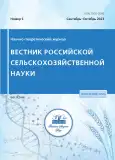The aim of the research is to study collection material of black currant in conditions of Kirov region and to identify varieties which combine high productivity, large fruits and resistance to bud mite (Cecidophyes ribes West.) and powdery mildew (Sphaerotheca mors-uvae (Schw) Berk et Gurt.). The researches had been held in an experimental garden of FSBSI FARC of the North-East (Kirov) in 2015-2021. The objects of the research were 36 black currant varieties of 2013 planting year. The check variety was Vologda. As a result of the research, source of the complex of economically valuable traits was distinguished: three varieties of Cherniy Zhemchug (Black Pearl), Chishma, Karachinskaya singled out for the combination of high productivity 62,3-142,0 c/ha (the exceeding of productivity over the check variety is 35,0% and more), for the large fruit (an average mass of a berry is 1,20 -1,70 g) and for high resistance to bud mite; the varieties Yadrenaya (Vigorous) and Gulliver were differed in a combination of high productivity 47,0 - 62,9 c/ha (the exceeding over the check variety is 35% and more), a large fruit (an average mass of a berry is 1,20 - 1,30), a high degree of resistance (the maximum degree of damage is 0,5 - 1,0 point) to powdery mildew and bud mite; two samples, Mila and Sputnik were identified for a combination of high productivity 46,7 - 49,6 c/ha (the exceeding of productivity over the check variety is 35,0% and more), for the large fruit (an average mass of a berry is 1,20 -1,80 g), a taste (4,0 points), a high degree of resistance (the maximum degree of damage is 0,5 - 1,0 point) to powdery mildew and bud mite. Complex resistance to powdery mildew and bud mite (the maximum degree of damage is 0 point during the research) was found in the Alexandrina variety.
 4-9
4-9


 10-13
10-13


 14-17
14-17


 18-21
18-21


 22-25
22-25


 26-32
26-32


 33-36
33-36


 37-41
37-41


 42-46
42-46


 47-51
47-51


 52-56
52-56


 57-60
57-60


 60-63
60-63


 64-67
64-67


 68-70
68-70


 71-77
71-77


 78-82
78-82


 83-89
83-89


 90-93
90-93


 93-97
93-97


 98-104
98-104












